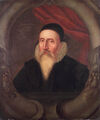Template:Selected anniversaries/July 13: Difference between revisions
No edit summary |
No edit summary |
||
| Line 22: | Line 22: | ||
||1896: Friedrich August Kekulé dies ... organic chemist. From the 1850s until his death, Kekulé was one of the most prominent chemists in Europe, especially in theoretical chemistry. He was the principal founder of the theory of chemical structure. | ||1896: Friedrich August Kekulé dies ... organic chemist. From the 1850s until his death, Kekulé was one of the most prominent chemists in Europe, especially in theoretical chemistry. He was the principal founder of the theory of chemical structure. | ||
|| | ||1904: Mathematician and adademic Alfred Leon Foster born. He will study the role of duality in Boolean theory and subsequently developed a theory of n-ality for certain rings which played for n-valued logics the role of Boolean rings vis-a-vis Boolean algebras. Pic. | ||
|| | ||1919: The British airship R34 lands in Norfolk, England, completing the first airship return journey across the Atlantic in 182 hours of flight. | ||
||1934 | ||1921: Gabriel Lippmann dies ... physicist and academic, Nobel Prize laureate. | ||
||1934: Mary E. Byrd dies ... astronomer and academic. | |||
File:IF-THEN-ELSE-END flowchart.svg.png|link=Artificial intelligence (nonfiction)|1956 – John McCarthy (Dartmouth College), Marvin Minsky (MIT), Claude Shannon (Bell Labs), and Nathaniel Rochester (IBM) assemble the first coordinated research meeting on the topic of "[[Artificial intelligence (nonfiction)|Artificial intelligence]]" at Dartmouth College in Hanover, NH. USA. | File:IF-THEN-ELSE-END flowchart.svg.png|link=Artificial intelligence (nonfiction)|1956 – John McCarthy (Dartmouth College), Marvin Minsky (MIT), Claude Shannon (Bell Labs), and Nathaniel Rochester (IBM) assemble the first coordinated research meeting on the topic of "[[Artificial intelligence (nonfiction)|Artificial intelligence]]" at Dartmouth College in Hanover, NH. USA. | ||
||Kurt Diebner | ||1964: Kurt Diebner dies ... nuclear physicist who is well known for directing and administrating the German nuclear energy project, a secretive program aiming to build nuclear weapons for Nazi Germany during the course of World War II. Pic. | ||
||1970 | ||1970: Leslie Groves dies ... American general and engineer (b. 1896) | ||
File:Skip Digits, Conductor.jpg|link=Skip Digits, Conductor|1972: Signed first edition of ''[[Skip Digits, Conductor]]'' sells for one million dollars; House Democrats say money trail leads to Richard Nixon. | File:Skip Digits, Conductor.jpg|link=Skip Digits, Conductor|1972: Signed first edition of ''[[Skip Digits, Conductor]]'' sells for one million dollars; House Democrats say money trail leads to Richard Nixon. | ||
| Line 38: | Line 40: | ||
File:Nixon April-29-1974.jpg|link=Watergate scandal (nonfiction)|1973: [[Watergate scandal (nonfiction)]]: Alexander Butterfield reveals the existence of the "Nixon tapes" to the special Senate committee investigating the [[Watergate scandal (nonfiction)|Watergate break-in]]. | File:Nixon April-29-1974.jpg|link=Watergate scandal (nonfiction)|1973: [[Watergate scandal (nonfiction)]]: Alexander Butterfield reveals the existence of the "Nixon tapes" to the special Senate committee investigating the [[Watergate scandal (nonfiction)|Watergate break-in]]. | ||
||1974 | ||1974: Patrick Blackett dies ... physicist and academic, Nobel Prize laureate. | ||
File:Hilary Putnam.jpg|link=Hilary Putnam (nonfiction)|1974: Mathematician and crime-fighter [[Hilary Putnam (nonfiction)|Hilary Putnam]] publishes his landmark paper arguing that mathematics is not purely logical, but "quasi-empirical", and that we should beware the possibility of "[[Crimes against mathematical constants|quasi-empirical crimes]]". | File:Hilary Putnam.jpg|link=Hilary Putnam (nonfiction)|1974: Mathematician and crime-fighter [[Hilary Putnam (nonfiction)|Hilary Putnam]] publishes his landmark paper arguing that mathematics is not purely logical, but "quasi-empirical", and that we should beware the possibility of "[[Crimes against mathematical constants|quasi-empirical crimes]]". | ||
||1983 | ||1983: Gabrielle Roy dies ... engineer (?) and author ... There is a quotation by her on the back of the Canadian $20 bill that reads: "Could we ever know each other in the slightest without the arts?" | ||
||Roberto Mario "Robert" Fano | ||2016: Roberto Mario "Robert" Fano dies ... computer scientist and academic. He was known principally for his work on information theory, inventing (with Claude Shannon) Shannon–Fano coding and deriving the Fano inequality. He also invented the Fano algorithm and postulated the Fano metric. Pic. | ||
||Norman Woodason Johnson | ||2017: Norman Woodason Johnson dies ... mathematician. In 1966 he enumerated 92 convex non-uniform polyhedra with regular faces. Victor Zalgaller later proved (1969) that Johnson's list was complete; the complete set is now known as the Johnson solids. Pic. | ||
</gallery> | </gallery> | ||
Revision as of 12:38, 3 September 2018
100 BC: Roman general and statesman Julius Caesar born. He will play a critical role in the events that led to the demise of the Roman Republic and the rise of the Roman Empire.
1527: Mathematician, astronomer, and astrologer John Dee born. He will achieve high status as a scholar and play a role in Elizabethan politics.
1956 – John McCarthy (Dartmouth College), Marvin Minsky (MIT), Claude Shannon (Bell Labs), and Nathaniel Rochester (IBM) assemble the first coordinated research meeting on the topic of "Artificial intelligence" at Dartmouth College in Hanover, NH. USA.
1972: Signed first edition of Skip Digits, Conductor sells for one million dollars; House Democrats say money trail leads to Richard Nixon.
1973: Watergate scandal (nonfiction): Alexander Butterfield reveals the existence of the "Nixon tapes" to the special Senate committee investigating the Watergate break-in.
1974: Mathematician and crime-fighter Hilary Putnam publishes his landmark paper arguing that mathematics is not purely logical, but "quasi-empirical", and that we should beware the possibility of "quasi-empirical crimes".





